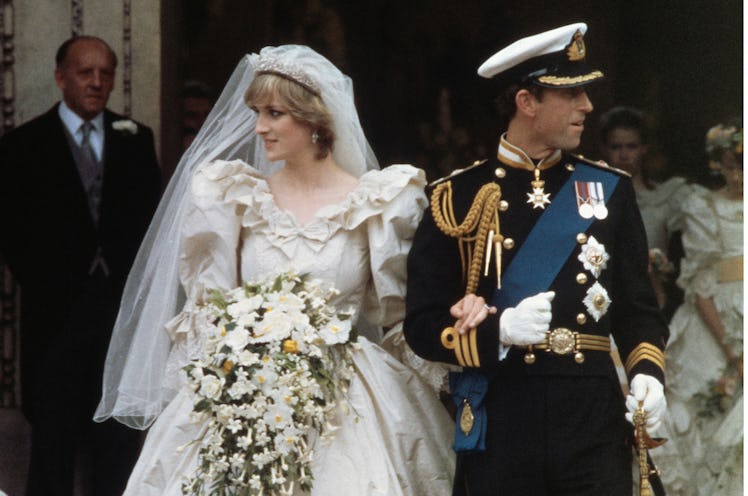
Diana & Charles' Wedding Day Body Language Suggested A Disconnect
When Lady Diana tied the knot with Prince Charles on July 29, 1981, it seemed like the stuff of fantasies — the plot of a magical Netflix romance about a nanny who becomes royalty overnight. But Princess Diana and Prince Charles' wedding day body language tells a different story. Over the years, more and more details have surfaced that suggest the couple hardly lived happily ever after once they said "I do" — and the subtleties in their physical postures and gestures seem to suggest that their bond was already a tad iffy.
Odds are you've seen at least a couple of photos from their history-making big day — after all, the ceremony remains the most-watched royal wedding of all time (yes, even surpassing the audience for Prince Harry and Meghan Markle's nuptials). Some standout details: Diana's trend-setting gown featured 10,000 pearls and a 25-foot train, they had 27 wedding cakes and their official cake was 5 feet tall, and an estimated 650,000 people lined the route from Clarence House just to catch a glimpse of the royal couple.
While the whole affair was nothing short of breathtaking, some troubling tidbits later emerged that lend more insight into what was going on behind the scenes. For one, when the couple was asked whether or not they were in love during their official engagement interview, Diana responded "of course," but Charles infamously added, "whatever love means" — a quip that Diana later said "traumatized" her in the documentary Diana: In Her Own Words.
What's more, Penny Thornton — Diana's astrologer — revealed in the documentary The Diana Interview: Revenge of the Princess that Charles reportedly told his fiancée he didn't love her the day they said "I do," which caused her to question whether she wanted to go through with the wedding. Royal biographer Andrew Morton also claimed that Diana considered calling it off due to his relationship with Camilla Parker Bowles (this is alluded to in The Crown after Diana finds the "Fred" and "Gladys" bracelets).
So, does their body language offer any hints about these issues? According to Traci Brown, body language expert and author of Persuasion Point: Body Language and Speech for Influence, there's a whole lot to glean from the photographs on their big day.
Leaning In
In this shot, Diana and Charles are clearly going in for a kiss — but notice how her left arm is hanging at her side, rather than wrapped around him? That one tiny detail is telling, according to Brown.
"It seems like they’re really focused on each other — but that’s not indicative of closeness," she explains.
BTW, fun fact: Charles reportedly forgot to kiss Diana at the end of their ceremony at St. Paul's Cathedral in London.
Reaching Out
As you can see, Charles is reaching for Diana's hand in this pic. But Diana hardly notices the gesture.
"She's not focused on him in this moment," says Brown.
Of course, we'll never know what she was focused on — but since she's facing the crowd, it's safe to say she was probably distracted by the throngs of people who have gathered to greet their new princess.
Still, Brown says it could possibly be an early sign of a disconnect.
Cozy In A Carriage
Again, Charles appears to focusing on Diana in this photograph, but her attention is elsewhere.
"He keeps trying to catch her eye and just isn't having any luck," says Brown.
Brown adds, however, that there was "plenty of chaos around them," so it's understandable that she might not notice him.
"But it’s also consistent with the disconnect we see in the other pics," she says.
A Missed Connection
Are you picking up on a running theme here? Charles is affectionately kissing Diana's hand, but as Brown points out, "she's barely giving him the time of day" and directing her gaze outward. Neither her torso nor her eyes are turned toward him. It's also worth noting that there's some physical distance between their bodies here.
An Intense Moment
It's impossible not to notice Charles' gesture during this moment, which was captured during the ceremony.
"People touch their head when they're super stressed," says Brown. "Could it be the intensity of just getting married? Maybe."
Meanwhile, Diana is gazing off in the opposite direction of Charles.
Restrained Affection
According to Brown, it looks like "this was a kiss for the crowd" — and indeed, there was apparently quite a bit of urging and cheering from onlookers that prompted them to go for it. They were the first royal couple to kiss on the Buckingham Palace balcony, but certainly not the last. In fact, this has now become a beloved tradition.
While they are locking lips, it's important to note that they're barely facing toward each other. Diana has to strain her neck to meet Charles' face.
"It could be just British stoic behavior, or it could be the stress of the hoopla around," explains Brown.
Or, it could suggest that there weren't a lot of romantic feelings behind the kiss.
Worlds Apart
In this photograph, Diana's arm is woven into Charles' — but it's important to note that not only are they not looking at each other, but their heads are turned away from each other in complete opposite directions.
"They're together in body but not in emotion or attention," explains Brown.
Sadly, during interviews recorded by journalist Andrew Morton in 1992 (the same year Diana and Charles separated), the late princess called her wedding day "the worst day of my life" — and certainly, their body language does seem to suggest some discomfort, distance, and doubt. Looking for more hidden insights into their relationship? You can still watch the footage from their wedding day, which is brimming with meaningful clues.
Source:
Traci Brown, body language expert
This article was originally published on